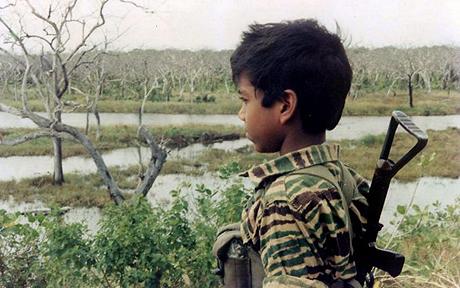The LTTE’s Forced Recruitment Of Children In Armed Combat

By Pitasanna Shanmugathas –August 23, 2016
During the ceasefire between the Liberation Tigers of Tamil Eelam (LTTE) and the Sri Lankan government, Human Rights Watch researchers went to Batticaloa, Trincomalee, and Kilinochchi to document the LTTE’s use of children in armed combat.
Human Rights Watch, in its report, documented instances where the LTTE forcibly recruited children through intimidation and torture, utilized acts of collective punishment against child soldiers, forcibly recruited more than one child per family, and re-recruited children who previously served. During the ceasefire, the LTTE continued to recruit large numbers of children. What is arguably most significant is that the LTTE’s forced recruitment of children further exacerbated the educational decline of Tamil youth. Now that the war is over, Tamil children may get a chance to further their level of education.
I interviewed Jo Becker, advocacy director of the children’s rights division at Human Rights Watch, and writer of the “Living in Fear” human rights report documenting the LTTE’s use of children in armed combat.
 Jo Becker discussed tactics utilized by the LTTE to force children into joining the rebel group. Despite resistance from Tamil parents, Becker stated, the LTTE would make repeated visits to the family, if a child is not given voluntarily, the LTTE would take one by force—for example, by abducting children.
Jo Becker discussed tactics utilized by the LTTE to force children into joining the rebel group. Despite resistance from Tamil parents, Becker stated, the LTTE would make repeated visits to the family, if a child is not given voluntarily, the LTTE would take one by force—for example, by abducting children.
Becker recalled a specific instance where a girl, due to persistent pressure and threats by the LTTE, decided to unwillingly join the LTTE in fear that “if she did not go they might take her younger sister.”
Another tactic utilized by the LTTE to recruit children, Becker recalled, was by forcing principals and teachers in schools to allow LTTE representatives to give “time in front of classrooms to talk about martyrs to the cause and talk about the responsibility of children to join.”
For instance, according to the Trincomalee Senior Superintendent of Police, the LTTE in July 2004 provided area teachers and principals with exams on the history of the LTTE.
An international worker in Trincomalee said, “The LTTE calls these history lessons. We call them propaganda campaigns. The LTTE says it’s not recruitment, and if individuals choose to join afterwards, so be it. Principals don’t have a choice. The LTTE doesn’t ask permission, they just go.”
In some places, Becker stated, “there were street theatre or public meetings where people were encouraged to join.”
Becker also disclosed stories from children she met who voluntarily joined due to government abuses by soldiers, for example, “maybe their mother had been killed or their father had been killed and [the children] held the government responsible.” “In many cases, these children joined the LTTE to get revenge. They weren’t pressured or coerced,” Becker stated.
A 1993 study of adolescents in Vaddukoddai in the North found that one quarter of the children studied had witnessed violence personally. In response, many children joined the LTTE, seeking to protect their families or to avenge real or perceived abuses.
However, Becker reiterated that “a majority of cases we documented, there was definitely some coercion of threat involved.”
I asked Jo Becker about the common misconception that the LTTE only recruited one child per family. As documented in the Human Rights Watch report, there were several instances where more than one child per family was recruited.

